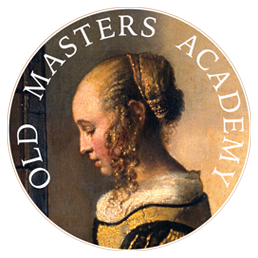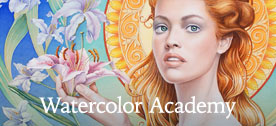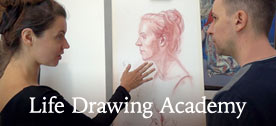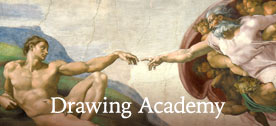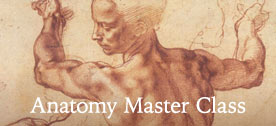Art Lesson 44, Part 4
Discover How to Paint Metal Objects
Learn how to paint like the Old Masters!
Old Masters Academy Online Course
Self-study, self-paced online video courseLifetime membershipOne-time payment: $487Enroll Now!Personal Tutoring online + Online Course
Unlimited tutoring by the Academy teachersLifetime membershipOne-time payment: $997Enroll Now!« Back to the Art Lessons List
Metal Surface Imitation in Oil Painting
This painting features a small three-piece still-life which includes a lamp, pewter vase, and violin. Traditionally, old masters put some meaning into the objects in their paintings. Sometimes a still-life was just an illustration of everyday objects surrounding a sitter and sometime it was used to reveal the sitter’s social status. In our particular case the still-life is casually arranged for compositional purposes.
As you can see, the still-life drawing has been shaped at the under-painting stage. This will ensure that light and shadow are balanced and defined from the very start. All the still-life is lacking at this moment is color, and that is exactly what we are about to proceed with.
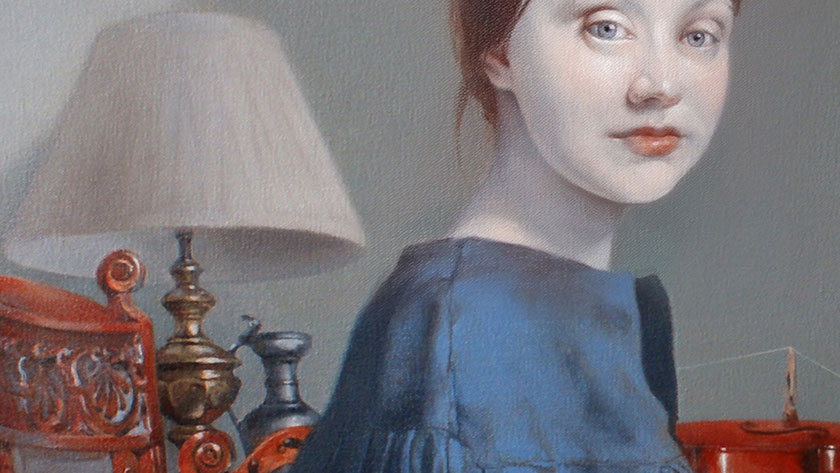
There are many methods of working on still-lifes. In our case we will use the time-tested and proven method of working from dark to light. The lamp’s base is painted, starting with darkest places, using Raw Sienna oil paint.
When all shadows are defined in Raw Sienna, you can continue with the middle tones, ensuring a smooth transition from dark to lighter areas. Such a transition is easier when you are working with still wet paint.
The pewter vase is painted in the same manner as the lamp base, starting with cold, dark blue shadows.
Let’s return to the lamp. Use the technique of working on several objects of the still-life at the same time. In this way, you concentrate on one object for a shorter period of time and then when you move to another object you will see it with fresh eyes. This will help you to make fewer mistakes in colors and shapes.
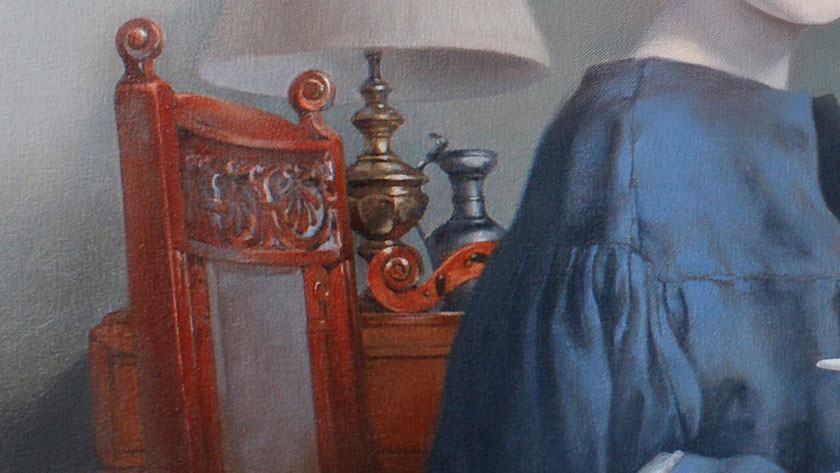
Progressing from dark colors to lighter ones makes it easier to mix different tones together. While the paint is still wet, work your brush to make a gradual transition from color to color between shades and mid-tones, expressing the smooth surface of metal objects. At the same time, on the bronze and pewter objects you will create sharper borders between the mid-tones and highlights. Use the trick of higher contrasts between light and mid-tone to make metal surfaces on the painting look realistic. You may return from time to time to outline and correct the tones of the darkest places. Pay attention to the relationship between lights and shadows.
The lampshade is made of very different material from the metal surfaces and therefore it will be painted in a slightly different way. Its 3D cylindrical shape gives a smooth and soft gradient from shadow to light. The gradient is different depending on whether it’s an inside or outside gradient. Observe how the tone gets lighter from left to right on the outside surface and then does the opposite on the inside, becoming lighter from right to left.
Here on the outside of the lampshade you can see the full gradation of light, starting from the brightest area of direct light, changing into half-tone lights and mid-tones and gradually transforming into shadows. You can also note that even the darkest areas of the lampshade are much lighter than other objects and will be painted in relationship to them. Also, there is reflected light from the walls highlighting the dark side of the lampshade, which makes it quite soft in tone and color.
The lampshade design and details can be painted to look soft, without strong lines or contrasts. The interesting pattern can be just suggested rather than illustrated with photographic precision. This suggestiveness will create the illusion of airy atmosphere around the objects and add depth to the painting.
When painting the highlights of the metal objects, do not be afraid of high contrasts between light and mid-tone. This contrast makes metal surfaces more realistic. To perfect the look of metal, try to paint the highlight contrasts well, and then the shadows and shapes will follow.
Metal is a very interesting and attractive material to paint. Many fine artists from all centuries were fascinated by precious metals and everyday metal objects. It was a matter of pride and joy to depict the intricate play of lights reflecting from metal surfaces. You can put in many nuances in color or go with a very limited palette, but one thing you should always try to achieve is the right balance between light and shade and highlight contrasts.
